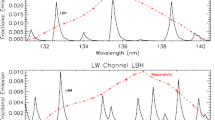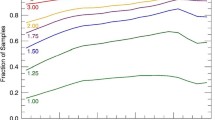Abstract
The NASA Ionospheric Connection Explorer Extreme Ultraviolet spectrograph, ICON EUV, will measure altitude profiles of the daytime extreme-ultraviolet (EUV) OII emission near 83.4 and 61.7 nm that are used to determine density profiles and state parameters of the ionosphere. This paper describes the algorithm concept and approach to inverting these measured OII emission profiles to derive the associated \(\mathrm{O}^{+}\) density profile from 150–450 km as a proxy for the electron content in the F-region of the ionosphere. The algorithm incorporates a bias evaluation and feedback step, developed at the U.S. Naval Research Laboratory using data from the Special Sensor Ultraviolet Limb Imager (SSULI) and the Remote Atmospheric and Ionospheric Detection System (RAIDS) missions, that is able to effectively mitigate the effects of systematic instrument calibration errors and inaccuracies in the original photon source within the forward model. Results are presented from end-to-end simulations that convolved simulated airglow profiles with the expected instrument measurement response to produce profiles that were inverted with the algorithm to return data products for comparison to truth. Simulations of measurements over a representative ICON orbit show the algorithm is able to reproduce hmF2 values to better than 5 km accuracy, and NmF2 to better than 12% accuracy over a 12-second integration, and demonstrate that the ICON EUV instrument and daytime ionosphere algorithm can meet the ICON science objectives which require 20 km vertical resolution in hmF2 and 18% precision in NmF2.



Similar content being viewed by others
References
D. Bilitza, International Reference Ionosphere 2000. Radio Sci. 36(2), 261–275 (2001). doi:10.1029/2000RS002432
D. Bilitza, B.W. Reinisch, International Reference Ionosphere 2007: improvements and new parameters. Adv. Space Res. 42, 599–609 (2008). doi:10.1016/j.asr.2007.07.048
P.D. Feldman, D.E. Anderson Jr., R.R. Meier, E.P. Gentieu, The ultraviolet dayglow. IV: The spectrum and excitation of singly ionized oxygen. J. Geophys. Res. 86(A5), 3583–3588 (1981). doi:10.1029/JA086iA05p03583
H.E. Hinteregger, K. Fukui, B.R. Gilson, Observational, reference and model data on solar EUV from measurements on AE-E. Geophys. Res. Lett. 8, 1147–1150 (1981). doi:10.1029/GL008i011p01147
T. Holstein, Imprisonment of resonance radiation in gases. Phys. Rev. 72, 1212–1233 (1947). doi:10.1103/PhysRev.72.1212
T.J. Immel et al., The Ionospheric Connection Explorer Mission: mission goals and design. Space Sci. Rev. (2017, this issue)
W.C. Martin, V. Kaufman, A. Musgrove, A compilation of energy levels and wavelengths for the spectrum of singly-ionized oxygen (OII). J. Phys. Chem. Ref. Data 22, 1179 (1993). doi:10.1063/1.555928
R.P. McCoy, D.E. Anderson Jr., S. Chakrabarti, \(\mathrm{F}_{2}\) region ion densities from analysis of \(\mathrm {O} ^{+} 834-\mathrm{A}\) airglow: a parametric study and comparisons with satellite data. J. Geophys. Res. 90(A12), 12257 (1985). doi:10.1029/JA090iA12p12257
R. Meier, The scattering rate of solar 834 Å radiation by magnetospheric \(\mathrm{O}^{+}\) and \(\mathrm{O}^{++}\). Geophys. Res. Lett. 17(10), 1613–1616 (1990). doi:10.1029/GL017i010p01613
R.R. Meier, J.M. Picone, Retrieval of absolute thermospheric concentrations from the far UV dayglow: an application of discrete inverse theory. J. Geophys. Res. 99(A4), 6307–6320 (1994). doi:10.1029/93JA02775
R.R. Meier et al., Remote sensing of Earth’s limb by TIMED/GUVI: retrieval of thermospheric composition and temperature. Earth Space Sci. 2, 1–37 (2015). doi:10.1002/2014EA000035
J.M. Picone, Influence of systematic error on least squares retrieval of upper atmospheric parameters from the ultraviolet airglow. J. Geophys. Res. 113, A09306 (2008). doi:10.1029/2007JA012831
J. Picone, R. Meier, O. Kelley, D. Melendez-Alvira, K. Dymond, R. McCoy, M. Buonsanto, Discrete inverse theory for 834-Å ionospheric remote sensing. Radio Sci. 32(5), 1973–1984 (1997a). doi:10.1029/97RS01028
J. Picone, R. Meier, O. Kelley, K. Dymond, R. Thomas, D. Melendez-Alvira, R. McCoy, Investigation of ionospheric of remote sensing using the 834-Å airglow. J. Geophys. Res. 102(A2), 2441–2456 (1997b). doi:10.1029/96JA03314
M.M. Sirk et al., Design and performance of the ICON EUV spectrograph. Space Sci. Rev. (2017). doi:10.1007/s11214-017-0384-2
A.W. Stephan, Advances in remote sensing of the daytime ionosphere with EUV airglow. J. Geophys. Res. Space Phys. 121, 9284–9292 (2016). doi:10.1002/2016JA022629
A.W. Stephan, J.M. Picone, S.A. Budzien, R.L. Bishop, A.B. Christensen, J.H. Hecht, Measurement and application of the O II 61.7 nm dayglow. J. Geophys. Res. 117, A01316 (2012). doi:10.1029/2011JA016897
D.E. Strickland, J. Bishop, J.S. Evans, T. Majeed, P.M. Shen, R.J. Cox, R. Link, R.E. Huffman, Atmospheric Ultraviolet Radiance Integrated Code (AURIC): theory, software architecture, inputs, and selected results. J. Quant. Spectrosc. Radiat. Transf. 62(6), 689–742 (1999). doi:10.1016/S0022-4073(98)00098-3
Acknowledgements
ICON is supported by NASA’s Explorers Program through contracts NNG12FA45C and NNG12FA42I. We acknowledge the input and feedback from the entire ICON team. AWS acknowledges the many contributions and productive discussions with J. Michael Picone, Kenneth F. Dymond, Robert R. Meier, and Douglas Drob.
Author information
Authors and Affiliations
Corresponding author
Additional information
The Ionospheric Connection Explorer (ICON) mission
Edited by Doug Rowland and Thomas J. Immel
Rights and permissions
About this article
Cite this article
Stephan, A.W., Korpela, E.J., Sirk, M.M. et al. Daytime Ionosphere Retrieval Algorithm for the Ionospheric Connection Explorer (ICON). Space Sci Rev 212, 645–654 (2017). https://doi.org/10.1007/s11214-017-0385-1
Received:
Accepted:
Published:
Issue Date:
DOI: https://doi.org/10.1007/s11214-017-0385-1




